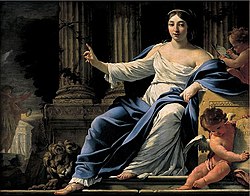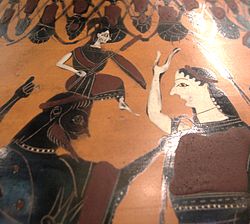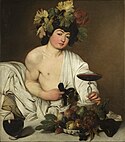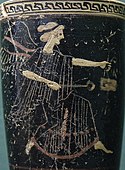Grecian and Roman mythology (1876) (14585185948)
Identifier: grecianromanmyth00dwi (find matches)
Title: Grecian and Roman mythology
Year: 1876 (1870s)
Authors: Dwight, M. A. (Mary Ann), 1806-1858 Lewis, Tayler, 1802-1877
Subjects: Mythology, Classical
Publisher: New York Chicago : A.S. Barnes
Contributing Library: The Library of Congress
Digitizing Sponsor: The Library of Congress
View Book Page: Book Viewer
About This Book: Catalog Entry
View All Images: All Images From Book
Click here to view book online to see this illustration in context in a browseable online version of this book.
Text Appearing Before Image:
which sacerdotal influence seeks to record andprolong. With the Greeks, however, over whom none of this influencewas exercised, such an attribute becomes an object of secondary im-portance, and is considered the effect of caprice, or of the modesty ofa young female ; and the poets at one time throw doubts on its reality,and at another upon its duration. Yet, virgin as she is, Diana pre-sides over the birth of children, a combination in which no one canmistake the union of the power which destroys with that which creates.We see, then, how incoherent are the traces of sacerdotal ideas,which survive this strange metamorphosis. The Hertha of Scythia,the Bendis of Thrace, the Isis of Egypt, the Diana of Ephesus, thatmotionless, enigmatical, and fettered mummy, become, beneath Gre-cian skies, a young and active huntress, who, in her course as rapid asthe winds, pursues on the mountain tops the timid inhabitants of thewoods. Diana is always represented as taller by the head than her attend-
Text Appearing After Image:
ARTEMIS OR DIANA. 200 GRECIAN AND ROMAN MYTHOLOGY. ants ; her face somewhat manly, her legs bare, well shaped and strong,her feet sometimes bare, and sometimes covered with the cothurnus*or buskin of the ancient hunters. By poets and artists, she is repre-sented as armed with bow and arrows, and has threescore nymphs inher train. She is also represented with a quiver and attended bydogs, and sometimes drawn in a chariot by two white stags or hernymphs. Again, she appears with, wings, holding a lion with one handand a panther in the other; or in a chariot drawn by two horses, onewhite and one black. The representations of this goddess are generally known by thecrescent on her head, by the dogs which attend her, and by herhunting habit. Isis, Diana, and the Bull Apis, are decorated with thecrescent, which announced the commencement of a new moon. Thedogs and buskins more particularly mark the goddess of the chase, asthe crescent was often used by the ancients as an ornament to thefemale
Note About Images
Relevantní obrázky
Relevantní články
OlympanéOlympané nebo olympští bohové nebo dvanáct olympských bohů či dvanáct olympanů je název pro dvanáct nejvýznamnějších bohů v řecké mytologii. Dvanáct nejvyšších bohů měli vedle Řeků také Etruskové a Římané, a tyto dvanáctky byly obvykle ztotožňovány. .. pokračovat ve čtení






































